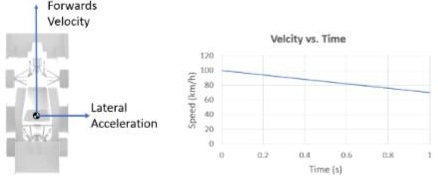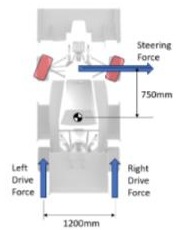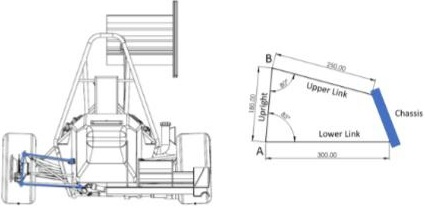Reference no: EM133524934
Problem 1: An engineer has mounted both wheel speed and acceleration sensors to a racing car. The car enters a cornet maintaining a constant lateral acceleration of 15 m/s2, The car applies its brakes and experiences constant deceleration over a period of 1s reducing its forward velocity from 100 km/h to 70km/h.

Determine the follow.:
a) Tangential acceleration of the vehicle.
b) Magnitude of vehicle acceleration.
c) Plot the radius of curvature vs. time for the 1s corner entry.
Problem 2:
A race car undergoes a test of its braking system. During a brake test the 280kg vehicle is expected to stop from 60 km/h to 0 km/h in as short a distance as possible. Assume the coefficient of friction from tyres is 1.5 and constant throughout the braking test. For the sake of simplicity assume that all the deceleration is due to the brakes (i.e. no aerodynamic drag) and all energy is dissipated through brakes.

Please determine the following:
a) The energy that needs to be dissipated (through the brakes) to stop the car (from 60km/h, assuming zero slope of road.
b) The distance travelled in the brake test, assuming zero slope of the road.
c) What would be the distance required to stop the vehicle from 60 km/h if the road was sloping downwards at an angle of 100.
d) What energy would be dissipated (through the brakes) to stop the car (from 60km/h) if the road is sloping downwards at an angle of 100
Problem 3: An engineer is considering adding torque vectoring to a race car by using two rear electric motors (torque vectoring is where motors on either side will apply a different force)
The race car weighs 280kg as pictured and has a radius of gyration of 0.6m. The maximum steering force that can be applied by the front two wheels (total) is 2300N. The maximum drive force that each drive motor could exert is 1200N in either a forwards or rearwards dinxtion.

Determine the following:
a) The angular acceleration of the car if only the steering force is applied.
b) The angular acceleration of the car if maximum torque vectoring is applied (i.e. the left drive force is 1200N forwards and the right drive force is 1200N backwards.
c) The angular acceleration of the car if both the steering Mr. and the maximum torque vectoring is applied.
Problem 4:
An engineer has decided to redesign the suspension system of a race car so that the lower link is parallel with the ground. The new dimensions are shown in the diagram. The suspension can be approximated as a planar 4 bar linkage. Assume for the instant shown point A is moving vertically at a speed of 50mm/s.

Determine the following for the instant shown:
a) The angular velocity of the lower link
b) The location of the instantaneous center of zero velocity of the upright (AB)
c) The angular velocity of the upright (AB)
d) The velocity of point B
e) The angular velocity of the upper link